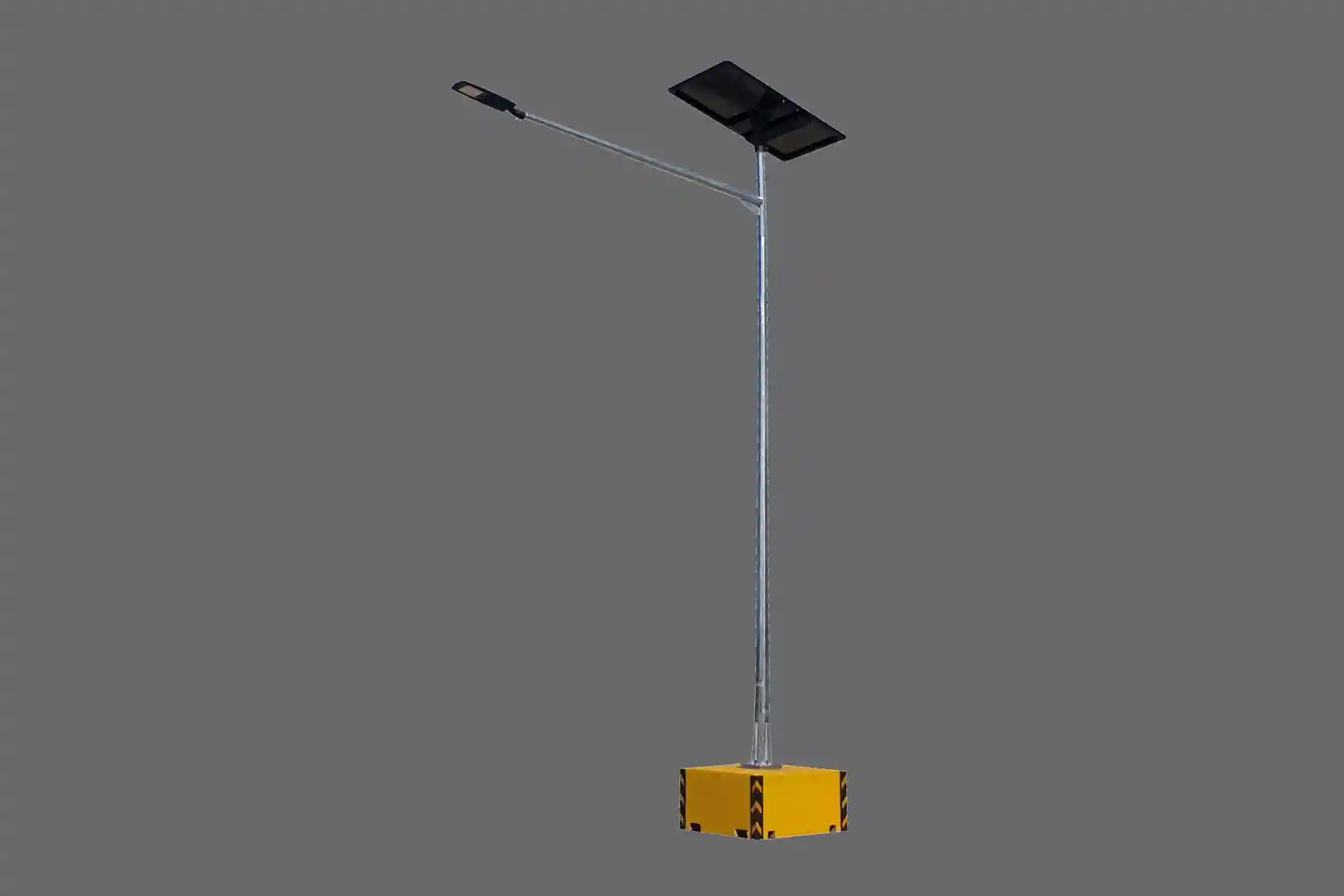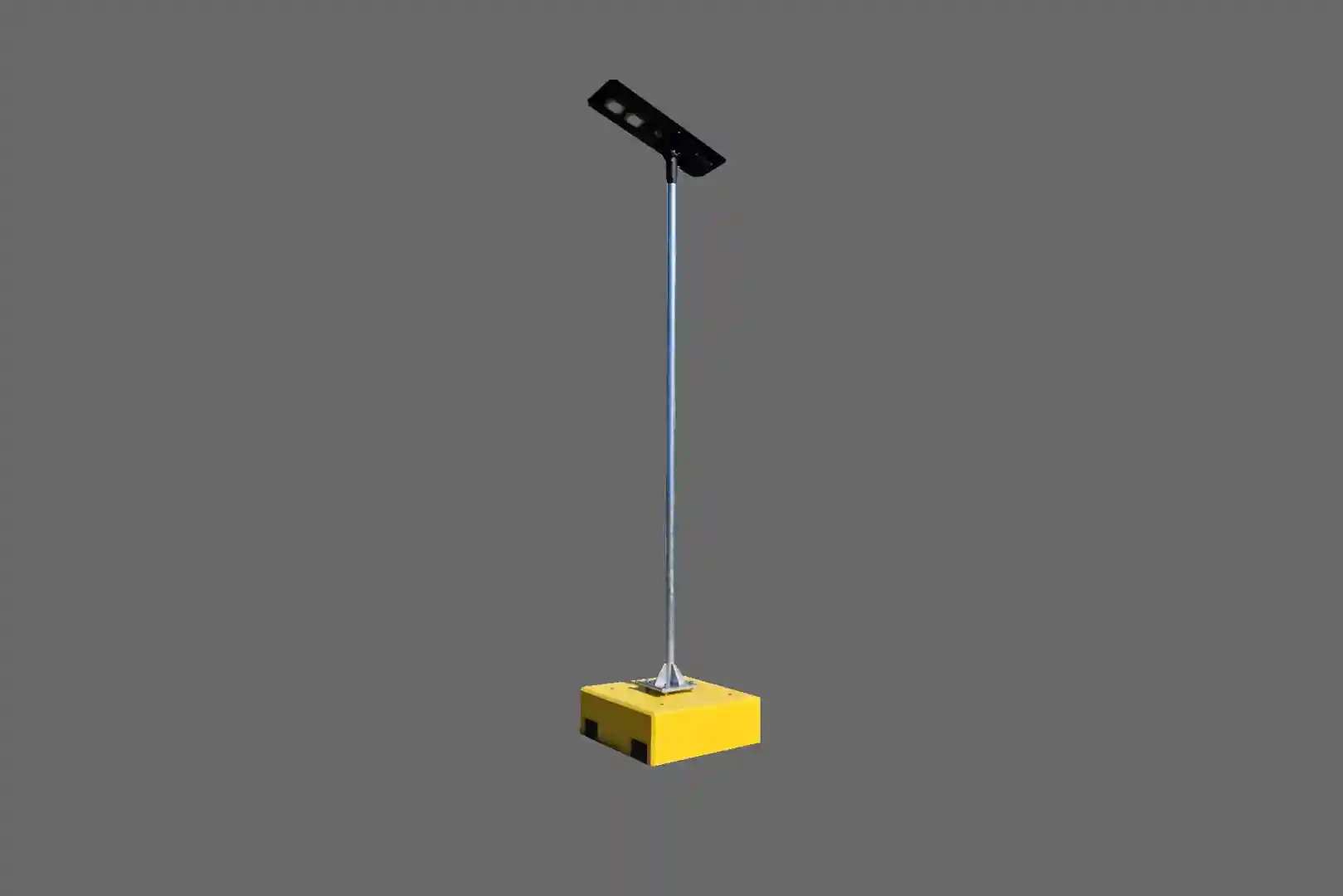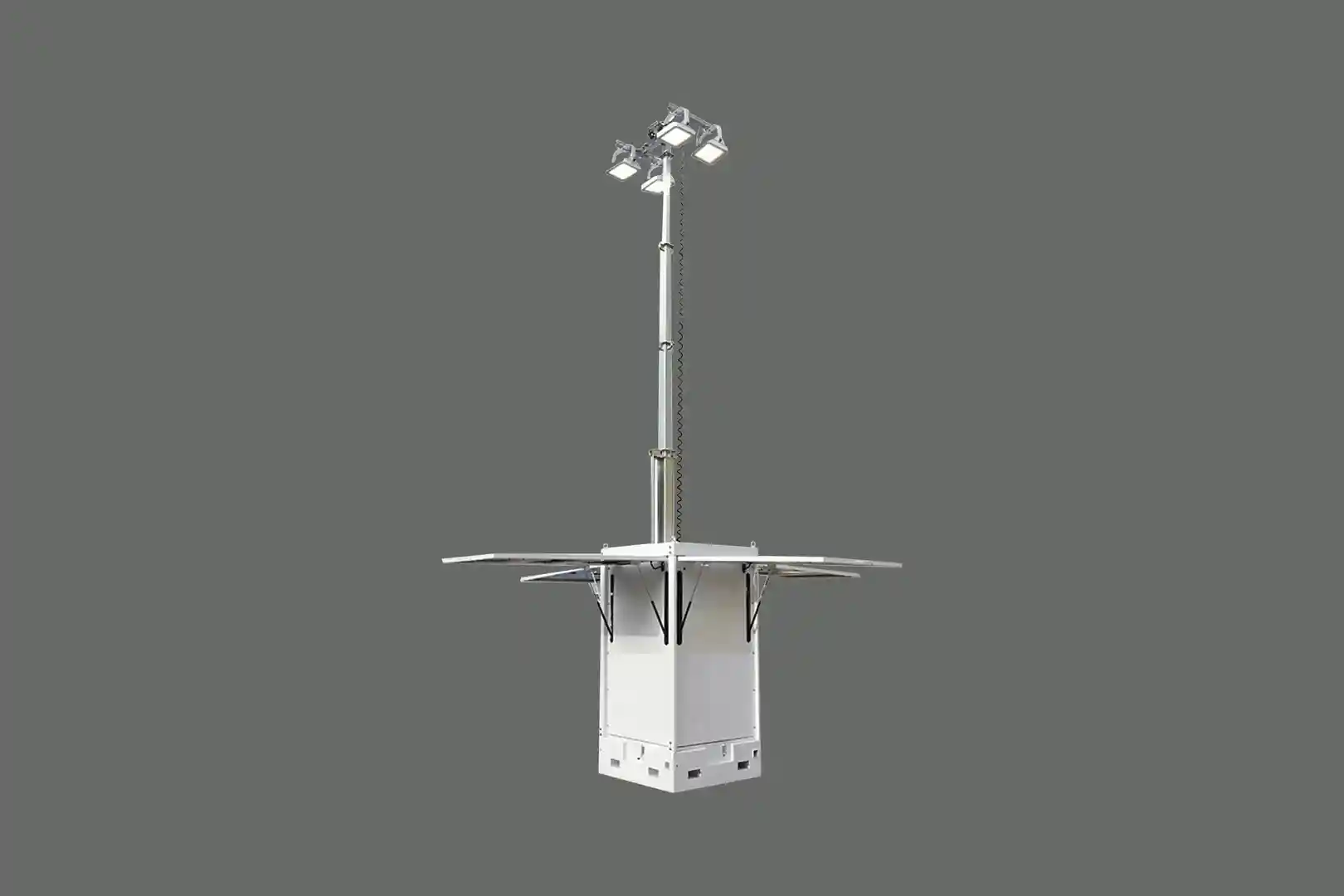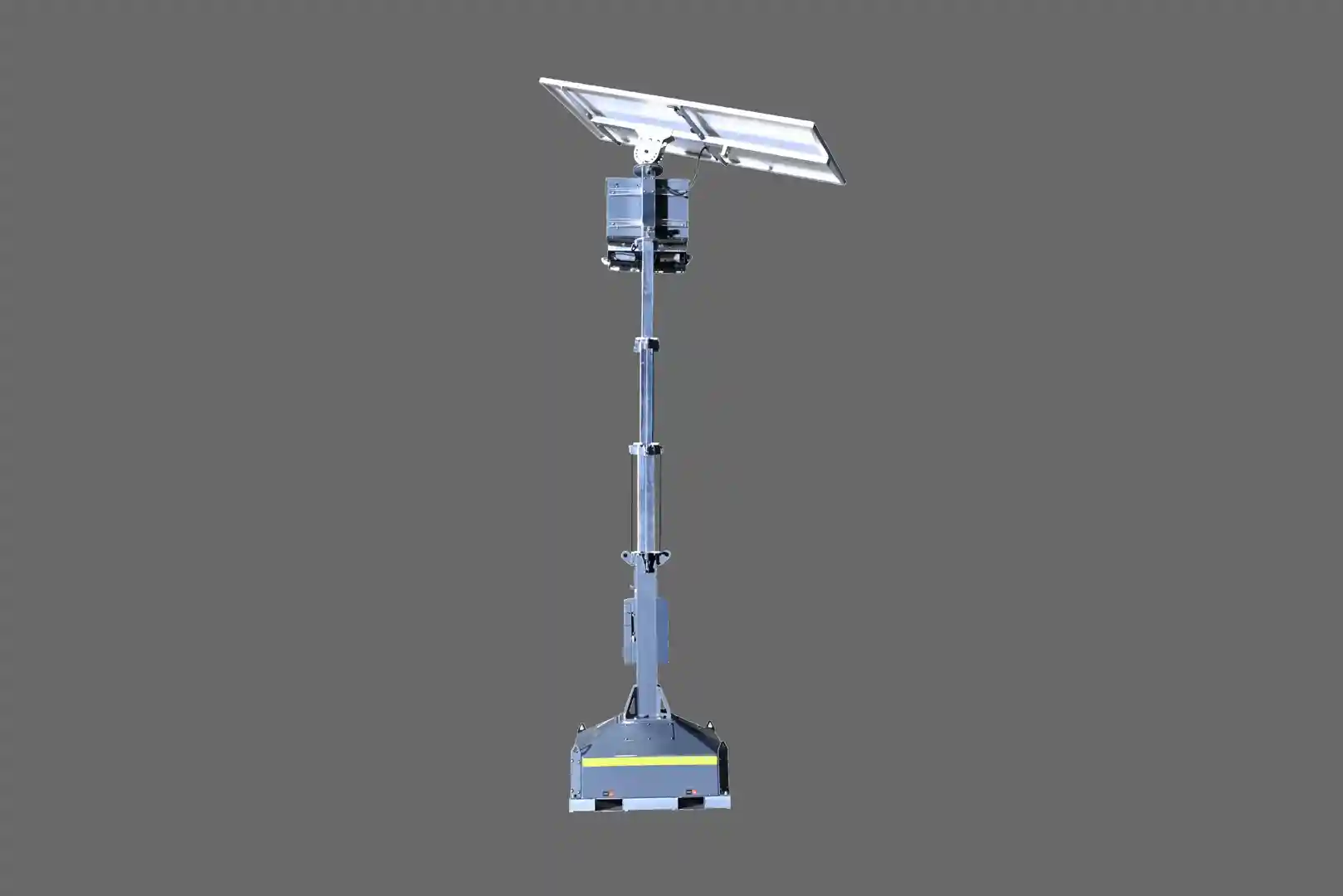A solar lighting tower is a mobile, self-contained lighting system that harnesses solar energy to power high-efficiency LED lights. These towers are engineered to provide reliable, grid-independent illumination from dusk until dawn, making them an essential tool for modern urban management. They offer a flexible and sustainable solution for lighting public parks, community event spaces, temporary infrastructure projects, and urban construction sites without the need for mains power or fossil fuels.
Core Advantages for Urban Environments
Solar lighting towers deliver a unique combination of economic, environmental, and operational benefits perfectly suited to the demands of Australian cities.
Economic Viability
- Zero Running Costs: Eliminates expenses related to diesel fuel, electricity consumption, and generator servicing.
- Reduced Labour: Rapid, often single-person deployment minimises setup time and associated labour costs.
Environmental Responsibility
- Zero Emissions: Operates without producing CO2, particulates, or other pollutants, contributing to cleaner urban air quality.
- Silent Operation: The absence of a diesel engine makes them ideal for use in residential areas, parks, and noise-sensitive locations, even overnight.
Operational Flexibility
- Rapid Deployment: Can be transported and set up in minutes, providing immediate lighting wherever it is needed.
- Grid Independence: Unaffected by power outages, ensuring consistent operation for critical safety and security lighting.
- Weather Resilience: Constructed to withstand harsh Australian weather conditions, from heavy rain to high winds.
Improved Urban Safety and Security
- Reliable Illumination: Provides bright, consistent light to improve visibility, deter crime, and improve public safety in parks, car parks, and walkways.
- Integrated Security Options: Many models can be equipped with CCTV cameras, creating a dual-purpose lighting and surveillance solution.
Key Applications in Australian Urban Spaces
- Public Parks and Plazas: Extending the safe, usable hours of community recreational areas.
- Urban Community Events: Providing silent, fume-free lighting for festivals, night markets, and outdoor performances.
- Temporary Infrastructure Projects: Illuminating nighttime roadwork, footpath repairs, and utility maintenance with minimal disruption.
- Urban Construction Sites: Ensuring safety and security on work sites located near residential or commercial properties.
- Emergency Response: Rapidly deploying lighting for incident management and public assistance points in urban emergencies.
- Seasonal and Overflow Parking: Safely illuminating temporary car parks for venues, shopping centres, and public transport hubs.
How Solar Lighting Towers Function: A Technical Breakdown
A solar lighting tower is an integrated system where each component is optimised for efficiency, durability, and autonomous operation. Understanding how these components work together reveals why they are such a reliable solution for urban applications.
Solar Energy Collection
The Photovoltaic Process
At the heart of the system are solar panels composed of photovoltaic (PV) cells. When sunlight strikes these cells, it excites electrons, creating a direct current (DC) of electrical energy. This process is silent, emission-free, and requires no moving parts.
High-Efficiency Monocrystalline Cells
Most high-performance solar lighting towers use monocrystalline silicon panels. These are highly efficient at converting sunlight to energy, meaning a smaller panel area is required to generate significant power—a key advantage for compact, mobile towers used in space-conscious urban settings.
Performance in All Weather
Modern solar panels are not reliant on direct, bright sunlight. They continue to generate a charge even on overcast or cloudy days, ensuring the battery system is consistently replenished for reliable year-round performance in Australian cities.
Energy Storage System
The Role of Deep-Cycle Batteries
The energy generated during the day is stored in deep-cycle batteries. Unlike car batteries, which are designed for short, powerful bursts of energy, deep-cycle batteries (such as GEL or Lithium-ion) are engineered to provide a steady stream of power over many hours and to be repeatedly discharged and recharged without degradation.
Ensuring All-Night Illumination
A correctly sized battery bank stores enough energy to power the LED lights throughout the entire night, even after a day with limited sun. This stored power ensures consistent, reliable illumination from dusk until dawn.
High-Efficiency LED Light Technology
Superior Energy Efficiency
Solar lighting towers use Light Emitting Diode (LED) luminaires, which are exceptionally energy-efficient. They produce a high level of brightness (measured in lumens) for a very low level of power consumption (watts), allowing the battery charge to last significantly longer.
Directed Light and Reduced Spill
Quality LED fixtures are designed with advanced optics that direct light precisely where it is needed, such as on a pathway or worksite. This minimises light pollution and unwanted light spill into neighbouring properties—a critical consideration for urban and residential environments.
Smart Control and Automation
Automated Dusk-to-Dawn Operation
An integrated photocell acts as a light sensor. It automatically detects ambient light levels, switching the lights on at dusk and off at dawn. This hands-free operation requires no manual intervention, saving time and ensuring lights are only active when needed.
Maximum Power Point Tracking (MPPT)
The solar charge controller uses MPPT technology to optimise the energy harvest. It constantly monitors the voltage from the solar panels and adjusts it to maximise the current flowing into the batteries, ensuring up to 30% more energy is captured compared to simpler controllers.
Urban Applications and Strategic Selection of Solar Lighting Towers
The adaptability of a solar lighting tower makes it a powerful tool for enhancing safety, productivity, and community life across a wide range of urban scenarios. From public parks to critical infrastructure projects, their self-sufficiency is a key advantage in dynamic city environments.
Primary Urban Applications
Enhancing Public Parks and Plazas
Solar lighting towers extend the usability of public spaces into the evening. They illuminate pathways, recreational facilities, and gathering spots, improving safety for visitors and discouraging anti-social behaviour without the cost of installing permanent electrical infrastructure.
Supporting Community Events and Festivals
For night markets, outdoor concerts, and local festivals, these towers provide essential lighting that is both silent and fume-free. Their rapid setup and removal align perfectly with the temporary nature of such events, ensuring minimal disruption to public spaces.
Illuminating Urban Construction and Maintenance
When conducting roadwork, utility repairs, or footpath upgrades at night, solar lighting towers provide critical safety lighting for workers and the public. Their silent operation ensures compliance with noise restrictions in dense residential and commercial areas.
Securing Temporary and Overflow Parking
Events, seasonal retail periods, or public transport hubs often require temporary parking solutions. Solar towers can illuminate these areas effectively, improving user confidence, enhancing security, and helping to prevent accidents and theft.
Strategic Selection Guide
Choosing the correct tower requires a methodical approach. Evaluating your project's specific needs against the tower's capabilities ensures a successful outcome.
Step 1: Assess Illumination Requirements
- Define the Coverage Area: Measure the length and width of the space that needs lighting to determine the required footprint.
- Determine Light Intensity: Match the brightness (lumens) to the task. General pathway lighting requires less intensity than a detailed work area.
- Consider Light Adjustability: Ensure the light fixtures can be aimed and adjusted to focus illumination precisely where it is needed.
Step 2: Evaluate Power System Performance
- Confirm Operating Hours: Define how many hours per night the lights must run to ensure the system can meet the demand.
- Verify Battery Autonomy: For critical applications, a system should have sufficient battery storage to operate for several consecutive nights without any sun for recharging. A 4-day autonomy is a common benchmark for reliability.
- Match Solar Array to Location: The size of the solar array must be sufficient to fully recharge the batteries, even during shorter winter days.
Step 3: Analyse Physical and Structural Specifications
- Mast Height and Stability: A taller mast provides wider light coverage but must be certified for stability, especially in windy conditions.
- Portability and Deployment Features: Look for integrated forklift pockets, crane lifting points, and a compact, trailer-mounted design for easy transport and positioning.
- Wind Load Certification: This is a non-negotiable safety requirement. Ensure any tower is certified to withstand the wind conditions expected at your location.
Step 4: Ensure Environmental Resilience
- IP Rating: Check the Ingress Protection (IP) rating, which indicates the level of protection against dust and water intrusion.
- Corrosion Resistance: For coastal cities or long-term deployment, a galvanised steel chassis and mast are essential to prevent corrosion.
Common Selection Mistakes to Avoid
Power System Miscalculations
- Undersized Battery Bank: Leads to lights failing before the night is over.
- Inadequate Solar Capacity: Results in insufficient charging, especially during winter, leading to system failure.
- Ignoring Autonomy: Failing to plan for consecutive overcast days leaves your site in the dark when reliability is most needed.
Quality and Safety Oversights
- Choosing Inferior Batteries: Low-quality batteries fail prematurely and require frequent, costly replacement.
- Missing Wind Certification: An uncertified tower is a significant safety hazard that can cause property damage or serious injury.
- Poor Build Quality: Inferior construction, welds, and coatings lead to rapid deterioration and operational failure.
Find Vizona’s Solar Lighting Tower Solutions for Urban Environments
At Vizona, we are an Australian-owned company specialising in solar lighting tower solutions engineered specifically for demanding local conditions. Our towers are built with sustainable materials and energy-efficient technologies to deliver best performance and reliability in urban settings, from busy event spaces to critical infrastructure sites.
EcoCivil Solar Lighting Towers – Fixed Pole

Ideal for semi-permanent applications where consistent, targeted illumination is required, the EcoCivil Fixed Pole tower is a mainstay of Australian urban infrastructure projects. Its fixed pole design allows light to be projected precisely over work zones, public walkways, or car parks. With customisable wattages and a robust, weather-resistant build, it serves as a reliable alternative to mains power.
Learn about our Fixed Pole Solar Towers.
EcoCivil Solar Lighting Towers – Mini Tilting Pole

Designed for projects demanding maximum efficiency and rapid deployment, the EcoCivil Mini Solar Tower features an innovative hinged pole that enables a single person to complete setup in minutes. This versatile tower is the perfect solution for temporary event lighting, footpath diversions, pop-up bike lanes, and overflow car parks where speed and convenience are paramount.
Find the versatile Mini Tilting Pole Tower.
EnviroCube Security Solar Lighting Tower

When a project requires both powerful illumination and integrated security, the EnviroCube delivers a comprehensive solution. It combines a heavy-duty ballast base with forklift pockets for easy transport and a galvanised telescopic mast for adjustable height. Featuring plug-and-play connections and an optional CCTV camera, it provides complete site monitoring for urban construction sites, public plazas, and event perimeters.
Secure your site with the EnviroCube Tower.
Guardian Security Pole Solar Lighting Tower

The Guardian Security Tower offers a flexible, portable, and environmentally friendly security and lighting solution. Its stable, sand-filled ballast and galvanised telescopic mast make it suitable for a variety of urban spaces. The high-efficiency LED system features auto-dimming capabilities to maximise battery life, while optional CCTV integration provides an added layer of security for parks and public facilities.
Explore the Guardian Security Tower.
Expert Guidance for Your Urban Lighting Project
Selecting the right solar lighting tower is simple with the right support. The Vizona team has extensive experience with Australian urban environments and compliance standards. We offer planning-stage support, lighting simulations, and expert guidance to help you specify the perfect custom solution for your project.
Phone: 1300 250 150 Email: info@vizona.com.au

